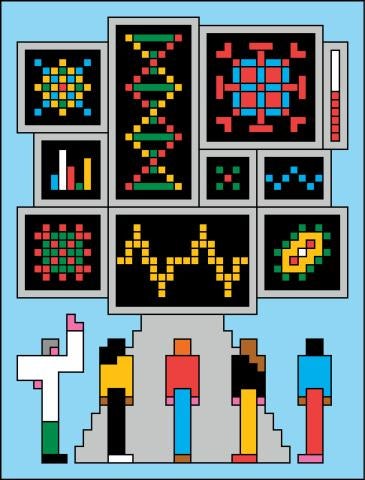
With AI, we can … Weave the technology deeper into the academic experience
Jeff Capadona, PhD, Case Western Reserve University’s vice provost for innovation, leads the campus mission to excel in the use of technological advances and educate students to succeed and lead in a rapidly changing world. CWRU Magazine recently spoke with Capadona, also the Donnell Institute Professor of Biomedical Engineering, about integrating artificial intelligence in academics at a time when the technology is both ubiquitous and dynamic.
Where did you start?
By listening to as many people as we could. We created a university task force on AI composed of faculty, staff and students from across campus, to provide a broad perspective. We launched a campuswide lunch and learn series, and last semester, we visited as many departments as possible and heard everything from, ‘This isn’t for us [right now],’ to ‘How can we go faster and how can we learn more?’
What most excites you?
Seeing how everything is connected, and how this critical moment is bringing the university together. For example, in our AI-across-disciplines seminars, our panel discussions have demonstrated how we can all learn from each other—we’ve seen engineers, for example, gain insights from law faculty and other faculty learn from colleagues at the dental, medical and nursing schools. There has been so much cross-pollination. It’s powerful.
Where is the university making the most advances?
We’re creating new majors. We’ve also tripled the number of AI courses to over 100 across 40 departments. We’re hiring faculty experts in disciplines not traditionally associated with AI, such as the humanities and social sciences. We’re also creating the infrastructure to expand the use of AI through additional training, workshops, seminars and learning communities. We’re investing from the top down and in every area.
What are some school highlights?
All of the schools are actively looking at the impacts and strategic integration of AI in teaching and learning. Here are some key examples: The College of Arts and Sciences recently launched a Humanity and Technology major, and the Writing Resource Center is building a self-paced module on how to write with and teach writing with AI. Case School of Engineering is developing an AI major and two minors. The Weatherhead School is one of our earliest adopters and is working with industry to get its students AI ready. The School of Medicine—which already uses HoloAnatomy—is working with the university’s Interactive Commons to integrate AI into headsets, allowing students to be trained on diagnostic processes and develop treatment plans working with virtual patients. The School of Law made national news for being the first law school to require students to pass an AI certificate program.
Is it a fine line—to integrate AI and use it responsibly?
Our approach is based on academic freedom. We’re providing tools and giving faculty the freedom to use them at their discretion. They can teach in whatever way is best for their learning objectives. We also have one of the world’s best AI ethicists on campus: Shannon French [CWRU’s Inamori Professor in Ethics]. She’s on the task force and keeps us thinking in different contexts about the ethical use of AI. We also encourage students to have an open dialogue with faculty and believe it is essential that they share with their professors how they envision using AI. To truly innovate the future of learning with AI, our campus must collaborate openly—addressing both adoption and concerns head-on.
What are the biggest curricular challenges?
I think the two biggest challenges are connected. First, the pace at which AI tools are changing is staggering. It’s hard to invest in any one thing because it could be obsolete in a week. We’re staying as flexible as possible while offering as much as we can. We developed the CWRU AI Playground last year with [U]Tech [University Technology] for faculty and staff to try out different AI tools before buying them. The second challenge is educating the educators with the knowledge and tools to understand the changes and evaluate the impact on their teaching and learning practices. We know faculty time is limited and spread thin. We’ve partnered with UCITE [the on-campus University Center for Innovation in Teaching and Education] for the training, which has been incredibly valuable. But we continue to navigate the challenge of reaching a critical mass when tools are evolving—and meeting each person where they are in terms of readiness, adoption and mastery.
More high school students already work with AI and enter CWRU with AI literacy.
Our students are going to come in more AI fluent. What are they expecting when they get here? What is the workplace expecting them to have when they graduate? We must ensure that the CWRU community not only keeps pace, but helps shape how AI is used in the world today’s students will eventually lead.
Photograph by McKinley Wiley/The Dark Room Co.


